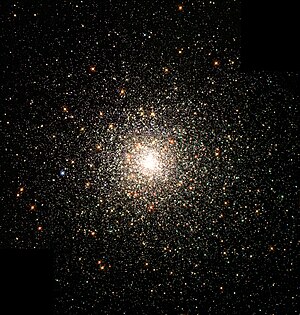Messier 80
Messier 80 (also known as M80 or NGC 6093) is a globular cluster located 32,620 light years away in the constellation Scorpius, it was discovered by Charles Messier in 1781, it was also one of his first discoveries.[1]
| Messier 80 | |
|---|---|
 Picture of Messier 80 taken by the Hubble Space Telescope (HST). | |
| Observation data (J2000 epoch) | |
| Class | II[2] |
| Constellation | Scorpius |
| Right ascension | 16h 17m 02.41s[3] |
| Declination | –22° 58′ 33.9″[4] |
| Distance | 32.6 kly (10.0 kpc)[3] |
| Physical characteristics | |
| 5.02×105[5] M☉ | |
| Estimated age | 13.5 ± 1.0 Gyr[6] |
| Other designations | M80, NGC 6093, GCl 39[7] |
| See also: Globular cluster | |
M80 can be seen in a field of the Milky Way that has many nebulae. It is located between Antares and Beta Scorpii when looking from Earth. With less light pollution, it can be seen as a round patch of light with a small telescope below the 67th parallel north.
It one of the densest globular cluster in the Milky Way.[1] It is at twice the distance of the Galactic Center in regions known as the Galactic halo. It contains many hundred thousand stars and has an apparent angular diameter of 10 arcminutes.[1] It is 32,600 light years away, making its true diameter around 95 light years.[1]
M80 contains a lot of blue stragglers. Blue stragglers are stars that seem younger than the rest. It is thought that this is because they lost some layers due to encounters or collisions with other stars in the dense cluster. With the help of the Hubble Space Telescope, images reveal many of these stragglers in the center of the cluster, suggesting a high rate of capture and collisions.[1]
On May 21, 1860, a nova was found in M80 that had an magnitude of +7.0 and was possible to see it using telescopes, binoculars and people with good vision.[1] This variable star, named T Scorpii, reached an absolute magnitude of −8.5 and briefly shone brighter than the cluster.[1]
References[change | change source]
- ↑ 1.0 1.1 1.2 1.3 1.4 1.5 1.6 "Messier 80". SEDS Messier Database. Students for the Exploration and Development of Space. Archived from the original on 2022-01-14. Retrieved 2021-12-19.
- ↑ Shapley, Harlow; Sawyer, Helen B. (August 1927), "A Classification of Globular Clusters", Harvard College Observatory Bulletin, 849 (849): 11–14, Bibcode:1927BHarO.849...11S.
- ↑ 3.0 3.1 Paust, Nathaniel E. Q.; et al. (February 2010), "The ACS Survey of Galactic Globular Clusters. VIII. Effects of Environment on Globular Cluster Global Mass Functions", The Astronomical Journal, 139 (2): 476–491, Bibcode:2010AJ....139..476P, doi:10.1088/0004-6256/139/2/476, hdl:2152/34371, S2CID 120965440.
- ↑ Goldsbury, Ryan; et al. (December 2010), "The ACS Survey of Galactic Globular Clusters. X. New Determinations of Centers for 65 Clusters", The Astronomical Journal, 140 (6): 1830–1837, arXiv:1008.2755, Bibcode:2010AJ....140.1830G, doi:10.1088/0004-6256/140/6/1830, S2CID 119183070.
- ↑ Boyles, J.; et al. (November 2011), "Young Radio Pulsars in Galactic Globular Clusters", The Astrophysical Journal, 742 (1): 51, arXiv:1108.4402, Bibcode:2011ApJ...742...51B, doi:10.1088/0004-637X/742/1/51, S2CID 118649860.
- ↑ Göttgens, Fabian; Kamann, Sebastian; Baumgardt, Holger; Dreizler, Stefan; Giesers, Benjamin; Husser, Tim-Oliver; Den Brok, Mark; Fétick, Romain; Krajnovic, Davor; Weilbacher, Peter M. (2021). "Central kinematics of the Galactic globular cluster M80". Monthly Notices of the Royal Astronomical Society. 507 (4): 4788–4803. doi:10.1093/mnras/stab2449.
- ↑ "M 80". SIMBAD. Centre de données astronomiques de Strasbourg. Retrieved 2006-11-16.
